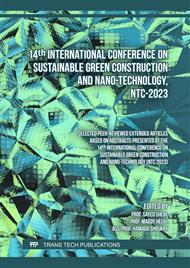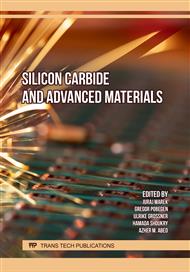[1]
Kavya Sree, S., et al., Experimental studies on mechanical and durability characteristics of lc3 concrete. IOP Conference Series: Materials Science and Engineering, 2021. 1091(1).
Google Scholar
[2]
Pierrehumbert, R.J.B.o.t.A.S., There is no Plan B for dealing with the climate crisis. 2019. 75(5): pp.215-221.
Google Scholar
[3]
Van den Heede, P., N.J.C. De Belie, and C. Composites, Environmental impact and life cycle assessment (LCA) of traditional and 'green'concretes: Literature review and theoretical calculations. 2012. 34(4): pp.431-442.
DOI: 10.1016/j.cemconcomp.2012.01.004
Google Scholar
[4]
Long, W.-J., et al., Design, dynamic performance and ecological efficiency of fiber-reinforced mortars with different binder systems: Ordinary Portland cement, limestone calcined clay cement and alkali-activated slag. Journal of Cleaner Production, 2022. 337.
DOI: 10.1016/j.jclepro.2022.130478
Google Scholar
[5]
Juenger, M.C., R.J.C. Siddique, and c. research, Recent advances in understanding the role of supplementary cementitious materials in concrete. 2015. 78: pp.71-80.
DOI: 10.1016/j.cemconres.2015.03.018
Google Scholar
[6]
Juenger, M.C., et al., Supplementary cementitious materials: New sources, characterization, and performance insights. 2019. 122: pp.257-273.
DOI: 10.1016/j.cemconres.2019.05.008
Google Scholar
[7]
Lothenbach, B., et al., Supplementary cementitious materials. 2011. 41(12): pp.1244-1256.
Google Scholar
[8]
Skibsted, J., R.J.C. Snellings, and C. Research, Reactivity of supplementary cementitious materials (SCMs) in cement blends. 2019. 124: p.105799.
DOI: 10.1016/j.cemconres.2019.105799
Google Scholar
[9]
John, V.M., et al., Fillers in cementitious materials—Experience, recent advances and future potential. 2018. 114: pp.65-78.
Google Scholar
[10]
Bernal, I.M.R., et al., Phase and microstructure evolutions in LC3 binders by multi-technique approach including synchrotron microtomography. Construction and Building Materials, 2021. 300.
DOI: 10.1016/j.conbuildmat.2021.124054
Google Scholar
[11]
Hemalatha, T. and A.J.J.o.c.p. Ramaswamy, A review on fly ash characteristics–Towards promoting high volume utilization in developing sustainable concrete. 2017. 147: pp.546-559.
DOI: 10.1016/j.jclepro.2017.01.114
Google Scholar
[12]
Giergiczny, Z.J.C. and C. Research, Fly ash and slag. 2019. 124: p.105826.
Google Scholar
[13]
Kadri, E.-H., et al., Silica Fume Effect on Hydration Heat and Compressive Strength of High-Performance Concrete. 2009. 106(2): p.107.
DOI: 10.14359/56454
Google Scholar
[14]
Sabir, B., et al., Metakaolin and calcined clays as pozzolans for concrete: a review. 2001. 23(6): pp.441-454.
DOI: 10.1016/s0958-9465(00)00092-5
Google Scholar
[15]
Martirena, F., J.J.C. Monzó, and C. Research, Vegetable ashes as supplementary cementitious materials. 2018. 114: pp.57-64.
DOI: 10.1016/j.cemconres.2017.08.015
Google Scholar
[16]
Wu, H.-L., et al., Engineering properties of vertical cutoff walls consisting of reactive magnesia-activated slag and bentonite: workability, strength, and hydraulic conductivity. 2019. 31(11): p.04019263.
DOI: 10.1061/(asce)mt.1943-5533.0002908
Google Scholar
[17]
Scrivener, K., et al., Calcined clay limestone cements (LC3). 2018. 114: pp.49-56.
DOI: 10.1016/j.cemconres.2017.08.017
Google Scholar
[18]
Yu J., et al., Compressive strength and environmental impact of sustainable blended cement with high-dosage Limestone and Calcined Clay (LC2). Journal of Cleaner Production, 2021. 278.
DOI: 10.1016/j.jclepro.2020.123616
Google Scholar
[19]
Saif, M.S., et al., Influence of blended powders on properties of ultra-high strength fibre reinforced self compacting concrete subjected to elevated temperatures. 2023. 18: p. e01793.
DOI: 10.1016/j.cscm.2022.e01793
Google Scholar
[20]
Zunino, F., K.J.C. Scrivener, and C. Research, The reaction between metakaolin and limestone and its effect in porosity refinement and mechanical properties. 2021. 140: p.106307.
DOI: 10.1016/j.cemconres.2020.106307
Google Scholar
[21]
Scrivener, K., et al., Impacting factors and properties of limestone calcined clay cements (LC3). 2018. 7(1): pp.3-14.
Google Scholar
[22]
Dhandapani Y., et al., Mechanical properties and durability performance of concretes with Limestone Calcined Clay Cement (LC3). Cement and Concrete Research, 2018. 107: pp.136-151.
DOI: 10.1016/j.cemconres.2018.02.005
Google Scholar
[23]
Avet, F., et al., Development of a new rapid, relevant and reliable (R3) test method to evaluate the pozzolanic reactivity of calcined kaolinitic clays. 2016. 85: pp.1-11.
DOI: 10.1016/j.cemconres.2016.02.015
Google Scholar
[24]
Avet, F., K.J.C. Scrivener, and C. Research, Investigation of the calcined kaolinite content on the hydration of Limestone Calcined Clay Cement (LC3). 2018. 107: pp.124-135.
DOI: 10.1016/j.cemconres.2018.02.016
Google Scholar
[25]
Alujas, A., et al., Pozzolanic reactivity of low grade kaolinitic clays: Influence of calcination temperature and impact of calcination products on OPC hydration. 2015. 108: pp.94-101.
DOI: 10.1016/j.clay.2015.01.028
Google Scholar
[26]
He, C., et al., Pozzolanic reactions of six principal clay minerals: activation, reactivity assessments and technological effects. 1995. 25(8): pp.1691-1702.
DOI: 10.1016/0008-8846(95)00165-4
Google Scholar
[27]
Baghban, M.H. and R. Mahjoub, Natural Kenaf Fiber and LC3 Binder for Sustainable Fiber-Reinforced Cementitious Composite: A Review. Applied Sciences, 2020. 10(1).
DOI: 10.3390/app10010357
Google Scholar
[28]
Alghamdi, H., et al., Performance Assessment of Limestone Calcined Clay Cement (LC3)-Based Lightweight Green Mortars Incorporating Recycled Waste Aggregate. 2023.
DOI: 10.1016/j.jmrt.2023.01.133
Google Scholar
[29]
Lin, R.-S., et al., Strengthening the performance of limestone-calcined clay cement (LC3) using nano silica. 2022. 340: p.127723.
DOI: 10.1016/j.conbuildmat.2022.127723
Google Scholar
[30]
Purushotham Reddy, K., et al., Comparative studies on LC3 based concrete with OPC & PPC based concretes. Materials Today: Proceedings, 2021. 43: pp.2368-2372.
DOI: 10.1016/j.matpr.2021.01.833
Google Scholar
[31]
Wang, D.L., M.L. Chen, and D.D.C.W. Tsang, Green remediation by using low-carbon cement-based stabilization/solidification approaches, in Sustainable Remediation of Contaminated Soil and Groundwater. 2020. pp.93-118.
DOI: 10.1016/b978-0-12-817982-6.00005-7
Google Scholar
[32]
Santhanam, M., et al. Perspectives on Durability of Blended Systems with Calcined Clay and Limestone. in Calcined Clays for Sustainable Concrete: Proceedings of the 3rd International Conference on Calcined Clays for Sustainable Concrete. 2020. Springer.
DOI: 10.1007/978-981-15-2806-4_65
Google Scholar
[33]
Dhandapani, Y. and M. Santhanam, Investigation on the microstructure-related characteristics to elucidate performance of composite cement with limestone-calcined clay combination. Cement and Concrete Research, 2020. 129.
DOI: 10.1016/j.cemconres.2019.105959
Google Scholar
[34]
Pillai, R.G., et al., Service life and life cycle assessment of reinforced concrete systems with limestone calcined clay cement (LC3). Cement and Concrete Research, 2019. 118: pp.111-119.
DOI: 10.1016/j.cemconres.2018.11.019
Google Scholar
[35]
Dhandapani, Y., M.J.C. Santhanam, and C. Composites, Assessment of pore structure evolution in the limestone calcined clay cementitious system and its implications for performance. 2017. 84: pp.36-47.
DOI: 10.1016/j.cemconcomp.2017.08.012
Google Scholar
[36]
Environment, U., et al., Eco-efficient cements: Potential economically viable solutions for a low-CO2 cement-based materials industry. 2018. 114: pp.2-26.
DOI: 10.1016/j.cemconres.2018.03.015
Google Scholar
[37]
Siddique, R. and J.J.A.C.S. Klaus, Influence of metakaolin on the properties of mortar and concrete: A review. 2009. 43(3-4): pp.392-400.
DOI: 10.1016/j.clay.2008.11.007
Google Scholar
[38]
San Nicolas, R., M. Cyr, and G.J.A.C.S. Escadeillas, Characteristics and applications of flash metakaolins. 2013. 83: pp.253-262.
DOI: 10.1016/j.clay.2013.08.036
Google Scholar
[39]
Antoni, M., et al., Cement substitution by a combination of metakaolin and limestone. 2012. 42(12): pp.1579-1589.
DOI: 10.1016/j.cemconres.2012.09.006
Google Scholar
[40]
Ferreiro, S., et al., Effect of raw clay type, fineness, water-to-cement ratio and fly ash addition on workability and strength performance of calcined clay–limestone Portland cements. 2017. 101: pp.1-12.
DOI: 10.1016/j.cemconres.2017.08.003
Google Scholar
[41]
Kawashima, S., et al., Influence of purified attapulgite clays on the adhesive properties of cement pastes as measured by the tack test. 2014. 48: pp.35-41.
DOI: 10.1016/j.cemconcomp.2014.01.005
Google Scholar
[42]
Kawashima, S., et al., Rate of thixotropic rebuilding of cement pastes modified with highly purified attapulgite clays. 2013. 53: pp.112-118.
DOI: 10.1016/j.cemconres.2013.05.019
Google Scholar
[43]
Santos, F.N., et al., Rheological study of cement paste with metakaolin and/or limestone filler using mixture design of experiments. 2017. 143: pp.92-103.
DOI: 10.1016/j.conbuildmat.2017.03.001
Google Scholar
[44]
Tregger, N.A., et al., Influence of clays on the rheology of cement pastes. 2010. 40(3): pp.384-391.
DOI: 10.1016/j.cemconres.2009.11.001
Google Scholar
[45]
Wang, L., et al., On the use of limestone calcined clay cement (LC3) in high-strength strain-hardening cement-based composites (HS-SHCC). Cement and Concrete Research, 2021. 144.
DOI: 10.1016/j.cemconres.2021.106421
Google Scholar
[46]
Huang, W., et al., Effect of cement substitution by limestone on the hydration and microstructural development of ultra-high performance concrete (UHPC). 2017. 77: pp.86-101.
DOI: 10.1016/j.cemconcomp.2016.12.009
Google Scholar
[47]
Yu, J. and C.K. Leung. Using limestone calcined clay to improve tensile performance and greenness of high-tensile strength strain-hardening cementitious composites (SHCC). in Calcined Clays for Sustainable Concrete: Proceedings of the 3rd International Conference on Calcined Clays for Sustainable Concrete. 2020. Springer.
DOI: 10.1007/978-981-15-2806-4_58
Google Scholar
[48]
Huang, K., Q. Ma, and D.J.A.i.C.E. Ma, Effect of basalt fiber on static and dynamic mechanical properties of metakaolin-based cement clay. 2020. 2020: pp.1-14.
DOI: 10.1155/2020/1359163
Google Scholar
[49]
Dehdezi, P.K., S. Erdem, and M.A.J.C.P.B.E. Blankson, Physico-mechanical, microstructural and dynamic properties of newly developed artificial fly ash based lightweight aggregate–Rubber concrete composite. 2015. 79: pp.451-455.
DOI: 10.1016/j.compositesb.2015.05.005
Google Scholar
[50]
Pan, T., C. Melgar, and T.J.J.o.m.i.c.e. Robinson, Damping capacity of styrene-butadiene latex admixed concrete: a micromechanical study. 2012. 24(9): pp.1237-1244.
DOI: 10.1061/(asce)mt.1943-5533.0000499
Google Scholar
[51]
Das, A.K. and C.K. Leung, The Use of Ultra-high Volume of Lime Stone Calcine Clay to Produce Basalt Fiber Reinforced Strain Hardening Cementitious Composites, in Strain Hardening Cementitious Composites: SHCC5. 2023, Springer. pp.13-22.
DOI: 10.1007/978-3-031-15805-6_2
Google Scholar
[52]
Yu, J. and C.K. Leung. Sustainable PVA Fiber-Reinforced Strain-Hardening Cementitious Composites (SHCC) with Ultrahigh-Volume Limestone Calcined Clay. in Calcined Clays for Sustainable Concrete: Proceedings of the 3rd International Conference on Calcined Clays for Sustainable Concrete. 2020. Springer.
DOI: 10.1007/978-981-15-2806-4_57
Google Scholar
[53]
Shoukry, H., et al., Performance of limestone-calcined clay cement mortar incorporating high volume ferrochrome waste slag aggregate. 2022. 350: p.128928.
DOI: 10.1016/j.conbuildmat.2022.128928
Google Scholar
[54]
Avet, F., et al., Investigation of CASH composition, morphology and density in Limestone Calcined Clay Cement (LC3). 2019. 115: pp.70-79.
DOI: 10.1016/j.cemconres.2018.10.011
Google Scholar
[55]
Maraghechi, H., et al., Performance of Limestone Calcined Clay Cement (LC 3) with various kaolinite contents with respect to chloride transport. 2018. 51: pp.1-17.
DOI: 10.1617/s11527-018-1255-3
Google Scholar
[56]
Favier, A. and K. Scrivener. Alkali silica reaction and sulfate attack: Expansion of limestone calcined clay cement. in Calcined Clays for Sustainable Concrete: Proceedings of the 2nd International Conference on Calcined Clays for Sustainable Concrete. 2018. Springer.
DOI: 10.1007/978-94-024-1207-9_26
Google Scholar



